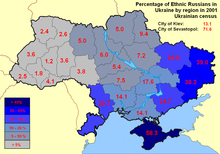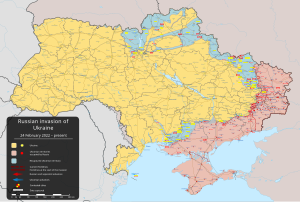Russian-occupied territories of Ukraine
The United Nations Human Rights Office reports that Russia is committing severe human rights violations in occupied Ukraine, including arbitrary detentions, enforced disappearances, torture, crackdown on peaceful protest and freedom of speech, enforced Russification, passportization, indoctrination of children, and suppression of Ukrainian language and culture.
On 30 September 2022, Russia announced the annexation of Donetsk, Luhansk, Zaporizhzhia and Kherson provinces, despite only occupying part of the claimed territory.
[10] Several Western-based analysts say that allowing Russia to keep the land it seized would "reward the aggressor while punishing the victim" and encourage further Russian expansionism.
[14] Soon after, Russian-installed officials announced and carried out a referendum for the region to join Russia, which western and independent organizations labeled as illegitimate.
[18] These separatists eventually created the Donetsk and Luhansk People's Republics,[19] and have since been at conflict with the now-pro-European Ukrainian government, known as the war in Donbas (Russia announced their "annexation" after the 2022 Russian invasion of Ukraine).
In response to Russian military intervention, the Parliament of Ukraine adopted government laws (with further updates and extensions) to qualify the Autonomous Republic of Crimea and parts of Donetsk and Luhansk regions as temporarily occupied and uncontrolled territories: Petro Poroshenko, one of the opposition leaders during Euromaidan, won a landslide victory in the election to succeed interim president Turchynov, three months after the ousting of Yanukovych.
[23] The following chart summarizes some estimates of the total area of Ukrainian territory under Russian control, presented by various publishers at different instances during the conflict.
("certain areas of Donetsk and Luhansk Oblasts", Ukrainian: Окремі райони Донецької та Луганської областей, romanized: Okremi raiony Donetskoi ta Luhanskoi oblastei)[35] The term first appeared in Law of Ukraine No.1680-VII (October 2014).
[40] The Ukrainian army was concerned in 2019 about the deployment of 3M-54 Kalibr cruise missiles on Russian naval and coast guard vessels operating in the Sea of Azov, which is adjacent to the temporarily occupied territories.
Temryuk and Taganrog, two other ports on the Sea of Azov, have allegedly been used to disguise the provenance of anthracite coal and liquefied natural gas (LNG) from the temporarily occupied territories.
[26] By 11 November 2022, the Institute for the Study of War calculated that Ukrainian forces had liberated an area of 74,443 km2 (28,743 sq mi) from Russian occupation,[54] leaving Russia with control of about 18% of Ukraine.
[10] Several Western-based analysts say that allowing Russia to keep the land it seized would "reward the aggressor while punishing the victim" and set a dangerous precedent.
"[60] Leo Litra of the European Council on Foreign Relations pointed out that allowing Russia to annex Crimea in 2014 did not stop further Russian aggression.
Since April, Russian forces tried to consolidate control in the region and capture the major city of Kharkiv after their withdrawal from Northern Ukraine.
In early September 2022, Ukrainian forces began a major counteroffensive and by 11 September 2022, Russia had retreated from most of the settlements it previously occupied in the oblast,[63] and the Russian Ministry of Defense announced a formal withdrawal of Russian forces from nearly all of Kharkiv Oblast stating that an "operation to curtail and transfer troops" was underway.
[68] On July 9, the Ukrainian government announced preparations for an imminent counteroffensive in the South, and urged the residents of occupied parts of Kherson and Zaporizhzhia Oblasts to shelter or evacuate to minimize civilian casualties in the operation.
[74] By early October 2022, Ukrainian forces had recaptured several more settlements as their counteroffensive operations shifted focus into the main territory of the oblast.
Raions of Mykolaiv Oblast that are occupied: Russia started the occupation as part of the northern campaign in the invasion of Ukraine in February 2022.
Eventually, the stagnant progress of the Russian Ground Forces led to their complete withdrawal from the oblast by early April, ending the occupation.
[3] Russia has been accused of neo-colonialism and colonization in Crimea by enforced Russification, passportization, and by settling Russian citizens on the peninsula and forcing out Ukrainians and Crimean Tatars.
Monuments and places of worship have been razed, while Ukrainian history books and literature deemed to be "extremist" have been seized from public libraries and destroyed.
[88] The International Court of Justice ruled that Russia had broken the Convention on the Elimination of Racial Discrimination by restricting school classes in the Ukrainian language in occupied Crimea.
[91] In March 2014, in a vote at the United Nations, 100 member states out of 193[92] did not recognize the annexation of the Crimea by Russia, with only Armenia, Belarus, Bolivia, Cuba, Nicaragua, North Korea, Russia, Sudan, Syria, Venezuela, Zimbabwe voting against the resolution[93] (see United Nations General Assembly Resolution 68/262).
The UN's position according to the resolution adopted in 2018: Condemning the ongoing temporary occupation of part of the territory of Ukraine, namely, the Autonomous Republic of Crimea and the city of Sevastopol (hereinafter referred to as "Crimea"), by the Russian Federation, and reaffirming the non-recognition of its annexation[40]In April 2018, PACE's emergency assembly recognized occupied regions of Ukraine as "territories under effective control by the Russian Federation".
[96][97] Chairman of the Ukrainian delegation to PACE, MP Volodymyr Aryev mentioned that recognition of the fact that part of the occupied Donbas is under Russia's control is so important for Ukraine.
[98] In early March 2022, in response to Russia's invasion, the United Nations General Assembly convened an emergency special session to discuss the latest developments regarding the peace situation in Ukraine, and adopted the United Nations General Assembly Resolution ES-11/1 to condemn Russia's invasion and Belarus's involvement.

- In Moldova: Transnistria (1), since 1992
- In Georgia: Abkhazia (2) and South Ossetia (3), since 2008
- In Ukraine: Crimea (4) and parts of Luhansk Oblast (5) and Donetsk Oblast (6) since 2014 , and parts of Zaporizhzhia Oblast (7) and Kherson Oblast (8) since 2022
















